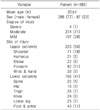Abstract
Methods
From January 1, 2010 to December 31, 2014, 1,664 people visited the emergency room due to a bicycle accident. Among them, 385 patients were found to have orthopedic injuries through physical examination and imaging evaluation. Intending to evaluate whether the number of bicycle injury patients is increasing or decreasing yearly, we investigated the rate of orthopedic injuries among bicycle injury patients, the damaged areas and the extent of damage, and also investigated whether changes in frequency were correlated with sex, age, or season.
Results
From January 1, 2010 to December 31, 2014, a total of 237,533 people came to the emergency room. Among them, the number of bicycle injuries was 1,664 (0.7%), and 23% of the bicycle injuries (385 people) were orthopedic injuries. Among these, 77.4% were men, 44.5% were less than 20 years old, and 20% were more than 61 years old. Damage to the forearm (n=82, 21.3%) and the shoulder (n=71, 18.4%) were the most common injuries, and simple fractures affected 274 patients (71.1%), overwhelmingly more common than other patterns of damage. In combination, simple fracture and dislocations occurred in 279 cases (72.5%).
Figures and Tables
 | Fig. 1Annual incidences of bicycle injuries between 2010 and 2014. Both total bicycle injury incidence and orthopedic patients showed a similar increasing trend in 2012 and 2014. |
 | Fig. 3The total incidence of body injuries during the 5 years. (A, B) Forearm injuries showed the greatest incidence in the 0–10 and 11–20 year groups. However, the shoulder and spine showed a relatively higher incidence in the 51–60 and ≥61 year groups than the other groups. Lower leg injuries and hip injuries showed the highest incidence in the 0–10 yr and ≥61 year groups, respectively. |
References
1. Cha YM, Lee SE. Study dissatisfaction factors and preferred items about clothes to wear when commuting by bicycle. J Korean Tradit Costume. 2012; 15:31–43.
2. Traffic Accident Analysis System. Traffic accident statistics 2014 [Internet]. Wonju (KR): Traffic Accident Analysis System;c2014. cited 2018 Feb 27. Available from: http://taas.koroad.or.kr/index.jsp.
3. McGoldrick NP, Green C, Burke N, Synnott K. Acute traumatic spinal injury following bicycle accidents: a report of three cases. Acta Orthop Belg. 2012; 78:409–413.
4. Eilert-Petersson E, Schelp L. An epidemiological study of bicycle-related injuries. Accid Anal Prev. 1997; 29:363–372.

5. Court-Brown CM, Allan M, Davidson E, McQueen MM. The epidemiology of cycling fractures in adults. Emergency Med. 2013; 3:139.
6. Jonsson A, Larusson SH, Mogensen A, Bjornsson HM, Mogensen BA. Incidence of bicycle injuries presenting to the emergency department in Reykjavik 2005–2010. Laeknabladid. 2016; 102:77–82.
7. Callaghan MJ, Phil M. Lower body problems and injury in cycling. J Bodyw Mov Ther. 2005; 9:226–236.

8. Scheiman S, Moghaddas HS, Bjornstig U, Bylund PO, Saveman BI. Bicycle injury events among older adults in Northern Sweden: a 10-year population based study. Accid Anal Prev. 2010; 42:758–763.

9. Nam YH, Lee MS. Epidemiological characteristics of bicycle-injured patients. J Korean Soc Sch Health Educ. 2013; 14:47–57.
10. Shin SJ, Ryoo HW, Park JB, et al. Characteristics and risk factors of bicycle injury. J Korean Soc Emerg Med. 2010; 21:328–334.
11. Traffic Accident Analysis System. Traffic accident statistics 2010 [Internet]. Wonju (KR): Traffic Accident Analysis System;c2010. cited 2018 Feb 27. Available from: http://taas.koroad.or.kr/index.jsp.
12. Lee DH, Kim BK, Yoon HK, Shin DE, Lee IS. Analysis of the in-patients who were admitted due to bicycle related injuries. J Korean Orthop Soc Sports Med. 2010; 9:58–64.




 PDF
PDF ePub
ePub Citation
Citation Print
Print








 XML Download
XML Download